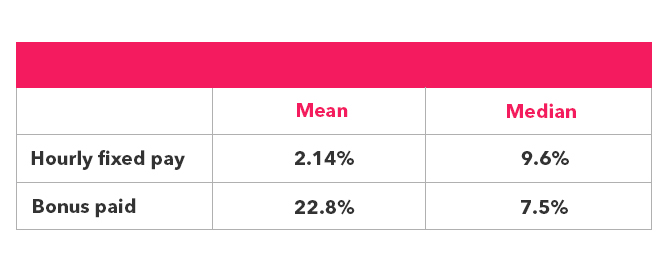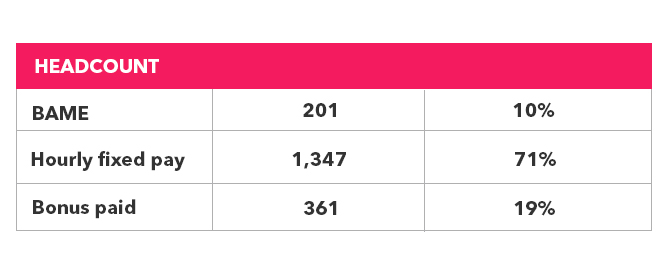Our 2020 gender and ethnicity pay gap report
At Vitality, we’re committed to diversity and inclusion because it’s good for our employees, for our business, and for society.
Diversity and inclusion chime with our shared value model, and advance our core purpose, which is to make people healthier and enhance and protect their lives. Diversity and inclusion are also explicitly called out in our values.
Gender pay gap report
We have succeeded in reducing our mean gender pay gap by 0.8% since last year and almost 6% since 2018. We’re confident that men and women get equivalent pay for equivalent work at Vitality. Our pay gap is explained by the under-representation of female employees in senior leadership roles. We are committed to increasing the number of women in these roles as positions become available, and will be able to draw on a strong layer of female talent at the level below the executive.
We’re confident that men and women get equivalent pay for equivalent work at Vitality. Our pay gap is explained by the under-representation of female employees in senior leadership roles. We are committed to increasing the number of women in these roles as positions become available, and will be able to draw on a strong layer of female talent at the level below the executive.
Vitality has launched a range of initiatives aimed at facilitating the advancement of women in our organisation, and we’re making good progress. We have:
• Signed up to the Women in Finance Charter
• Set a target for female appointments at senior levels, and increased the percentage of women in senior roles
• Enhanced and equalised parental leave entitlements, and signed up to the Association of British Insurers’ transparent parental leave and pay initiative
• Changed our recruitment and selection practices to source more talented women, including promoting flexible working options and ensuring our job adverts use gender neutral language
• Launched a mentoring programme for high performing, high potential employees (the majority of them women)
• Applied a gender lens to succession planning to develop a female talent pipeline
• Introduced a Women’s Forum to advise on gender issues
• Signed up to the Chartered Insurance Institute’s Insuring Women’s Futures campaign
• Introduced child-minding and menopause support benefits for employees
• Piloted Lean-In circles for female employees.
In addition, we have:
• Administered a diversity and inclusion survey
• Set up a business-wide network of diversity and inclusion champions
• Rolled out unconscious bias training to all managers, and included a module on diversity and inclusion in annual compulsory training for all employees
• Developed a D&I calendar, which marks important dates for the many affinity groups making up our employee base: employee representatives are invited to share what the day means to them and how they will be observing it
• Applied a D&I lens to our engagement survey analysis
• Published our commitment to diversity and inclusion on our careers site.
These initiatives have also supported our focus on other aspects of diversity and inclusion, including ethnicity.
Pay and bonus gap

This table reflects our gender pay gap at the snapshot date (5 April 2020).
BONUS DISTRIBUTION
-
MEN
![Pie chart illustrating bonus distribution]()
Men 88%
-
WOMEN
![Illustration on bonus distribution pie chart]()
Women 88%
PAY QUARTILES
447 or 478 employees in each quartile (1909 in total).
-
Lowest
![Pie chart]()
-
Quartile 2
![Pie chart]()
-
Quartile 3
![Pie chart]()
-
Highest
![Pie chart]()
Our ethnicity pay gap for 2020, calculated using data provided voluntarily by employees in December 2020, was 2.14%.

The profile of employees who have disclosed their ethnicity is detailed below:

Our ethnicity pay gap is explained by the under-representation of BAME employees in senior leadership roles. We are confident employees receive equivalent pay for equivalent work regardless of their ethnicity. We are committed to increasing the number of BAME employees in senior leadership roles and developing a strong talent pipeline of BAME employees.
To support the advancement of BAME employees at Vitality, we’ve launched a range of initiatives, in consultation with our BAME Forum, including:
• Focusing our 2020 diversity and inclusion e-learning module on race awareness
• Rolling out additional race fluency training to all employees
• Exploring recruitment partnerships with agencies specialising in BAME talent, and asking agencies to include BAME candidates among the CVs they send us
• Ensuring that more BAME employees participate in our mentoring programme
• Signing the Race at Work Charter
• Supporting a campaign to make ethnicity pay gap reporting mandatory
• Launching a D&I hub on our internal communications platform to coincide with Black History Month.

Judy Parfitt
Chief People Officer, Vitality





